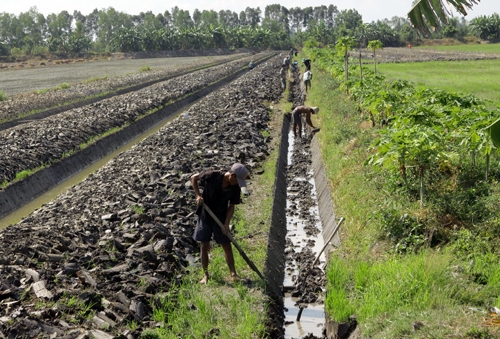 Economy
Economy

Fewer rice fields will be converted to cash crops in the ongoing summer-autumn crop in the Mekong Delta this year as farmers lack stable outlets, according to the Ministry of Agriculture and Rural Development’s (MARD) Plant Cultivation Department.
 |
| Farmers in Hậu Giang Province have switched from growing three rice crops to two rice crops and one cash crop a year. — VNA/VNS Photo Duy Khương |
HCM CITY — Fewer rice fields will be converted to cash crops in the ongoing summer-autumn crop in the Mekong Delta this year as farmers lack stable outlets, according to the Ministry of Agriculture and Rural Development’s (MARD) Plant Cultivation Department.
Since saltwater intrusion occurs every year in the delta, converting ineffective rice fields to other crops is necessary to reduce risks and save water. Profits from cash crops can also increase farmers’ incomes.
In 2014-15, the delta, the country’s rice granary, converted 112,000 ha of rice fields to cash crops, but only 45,200 ha of rice fields will be converted this year.
The decline is due to unstable outlets, weak linkages between farmers and companies, and a shortage of concentrated cultivation areas for cash crops, according to the Plant Cultivation Department.
MARD said that a total of 200,000 ha of rice fields would be converted to cash crop cultivation in the Mekong Delta from now to 2020.
Experts have said that preferential policies and more mechanisation are needed to promote the conversion of rice fields to other crops.
The converted areas for the summer-autumn crop this year are located mostly in Vĩnh Long, Đồng Tháp, Tiền Giang, An Giang and Long An provinces.
The crops are sweet potato, vegetables, aquatic species, sesame, watermelon, corn, chilli, dragonfruit and others.
In An Giang Province, farmers will switch to growing sesame and corn on 2,700 ha of rice fields in the summer-autumn crop.
Nguyễn Thanh Phong, a farmer in Long Xuyên City’s Mỹ Hoà Hưng Commune in An Giang, said his rice fields had been converted to sesame cultivation in the summer-autumn crop.
“Sesame earned a profit of VNĐ30 million (US$1,300) per ha last year, higher than rice cultivation,” he said.
Trần Anh Châu, chairman of the Mỹ Hoà Hưng Commune Farmers Association, said the model of rotating sesame and rice cultivation on the same fields had offered higher profits.
“But the outlet for sesame was still not stable, as farmers had to sell directly to traders, without guaranteed prices,” he said.
Trần Bá Hoàng, deputy director of Tiền Giang Province’s Department of Agriculture and Rural Development, said farmers had been encouraged to reduce one rice crop a year to grow other cash crops.
However, the cultivation of corn and bean varieties used to produce animal food has not attracted farmers and companies, as production costs are higher than imported corn and beans. — VNS









